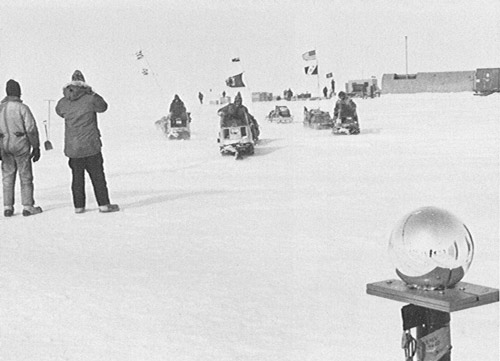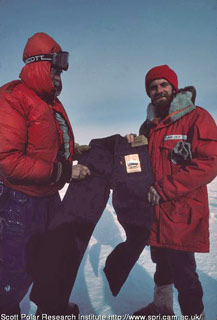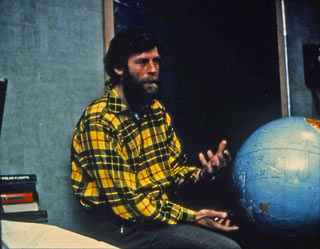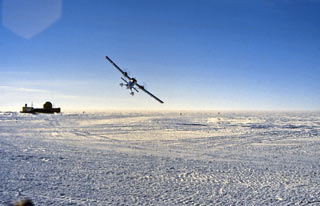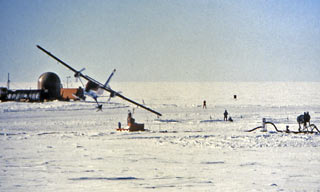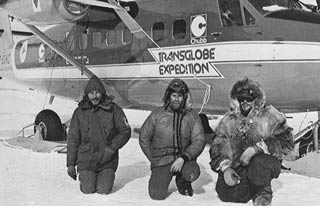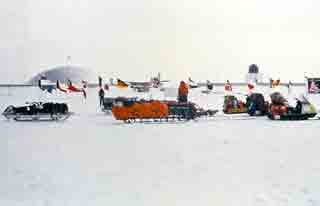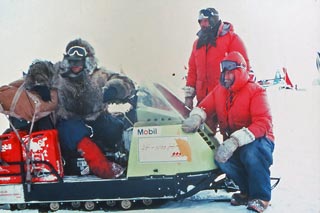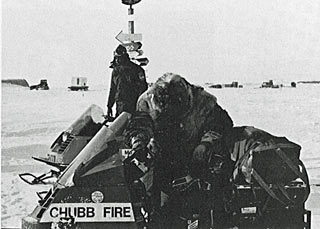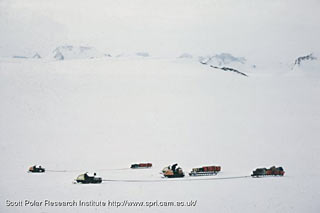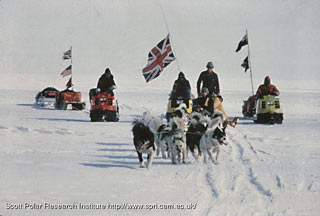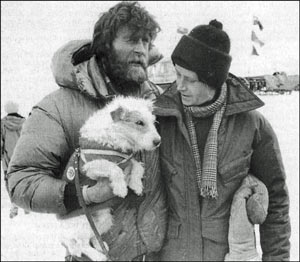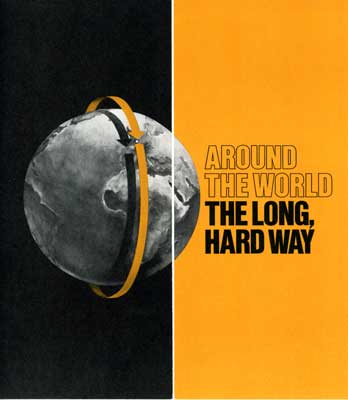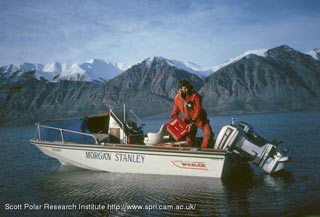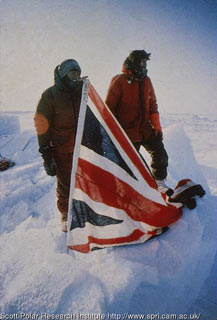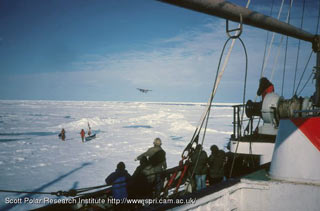The Transglobe Expedition (continued)
|
They were greeted enthusiastically by the 60-some Polies on station. They set up a camp 100 yards away from the dome, but they were offered meals in the station in return for galley house mouse. There are only five pages in Ran's book about the time at Pole, and NO photos (at least in the American edition; more on that below). Still, the book includes a significant discussion of the problems with the sewer outfall, which had overflowed into the utilidor the previous season and was causing the dome and utilidor to settle in that direction. Ran also describes the station manager--Tom Plyler, a former Marine lieutenant and Vietnam veteran, as a strict disciplinarian. For some unknown reason, Ran and Tom had a well- documented discussion (right) about Levi's jeans, although the Transglobe team didn't have any. (Tom had previously wintered in 1975 as the power plant mechanic.) Tom had a black belt in karate, and after he gave a demonstration, he challenged Ran to a wrestling match in the gym...Tom was given a British Army lock which knocked out his forearm for the evening...while Ran felt he'd almost had his neck dislocated. On a healthier note, Tom described the treated Kleenex, which had been developed by Dr. Harold Muchmore et al as part of his long-term Pole medical project.
As these events were happening, Ginnie and Simon packed up the equipment at Ryvingen. Some of the gear would be shipped back to London from Sanae, to be refurbished for use in the Arctic. On 21 December they left Ryvingen--Giles flew them, with Bothy, to Pole. Below, Giles is seen doing the same sorts of maneuvers he showed us on his first visit to Pole in November 1976 (CH). | ||
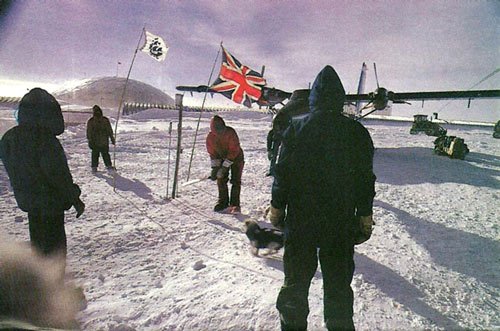 Then it was time for the Brits to beat the Americans in the first (and only?) cricket match ever conducted at Pole. Bothy is in front of the batsman, and the aircraft is on the taxiway behind the pitch (photo information). | ||
|
And there was time for hero shots... |
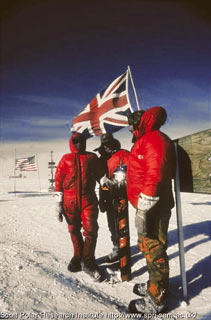 ...and at the more traditional location (SPRI). | |
|
There was some thought given to staying at Pole through Christmas, but Ran wanted to be on the way...and Ginnie reminded them that the Christmas Day house mouse might be worth avoiding. So they made plans to leave on 23 December...the next leg of the trip would be the 210 miles to the head of the Scott Glacier. It was time to pack things up... | ||
|
They headed out at 1240 on the 23rd, to the accompaniment of clicking cameras...and Ran immediately realized he was heading in the wrong direction, although he decided to wait until he was out of sight before correcting his course. Things went smoothly until they neared the head of the glacier, where they encountered crevassed areas. After getting through them, they were resupplied by Giles, who then flew reconnaissance ahead of their route, which of course included many more crevassed areas. Things went much faster on the Ross Ice Shelf, despite the fact that they encountered temperatures above freezing. In the meantime, Giles made a trip from McMurdo to Pole on 3 January to bring Ginnie, Simon Grimes, and Bothy to Scott Base. Giles Kershaw made his last fuel delivery to the team on 8 January when the team was at 80º51'S, and he brought with him Roger Clark, the Scott Base manager. During the brief visit he had a beer with them and discussed arrangements for their stay at Scott Base. As they approached Ross Island, at 1800 on 11 January, Roger came out to the Transglobe team, driving a dogsled drawn by Huskies. He led them to Pram Point and Scott Base, the end of the 67-day Antarctic crossing. | ||
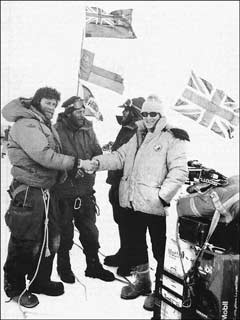 Ran (left) is greeted by Roger Clark as they near Scott Base (Roger had been born in England but more recently was living in the Christchurch area) (AD). |
||
|
The Benjamin Bowring docked in Winter Quarters Bay on 20 January, after some assistance from the U.S. Coast Guard icebreaker Polar Star (Ran notes in his book that the icebreaker crew was especially excited that day, as the Iranian Embassy hostages had just been released.) After refueling and resupply, the vessel left later the same day for a science cruise for DSIR. The ship sailed for Lyttelton with the expedition team on 16 February, arriving on 27 February. After a drydock period, the ship and expedition team conducted trade shows in Auckland and Sydney before heading to the next such event in Los Angeles...
I was living in Newport Beach at the time, and of course was following the expedition as much as possible during those pre-Internet days, so I was particularly excited to see a feature article about the expedition in the 26 May Los Angeles Times, including the announcement of their trade show in Los Angeles Harbor through Saturday 30 May. Of course I had to go. The exposition was held in a dockside building next to where the Benjamin Bowring was docked. There were exhibits of the snowmobiles and other expedition equipment, demonstrations of the "pontoon skis" (large buoyant water-ski shaped pontoons) which they proposed to use to cross leads between Arctic ice floes (as far as I know these were not actually used), and posters with many photos of the expedition so far. As it was in a rather deserted dock area, the exposition was rather poorly attended. I took photos which seem to have disappeared, and as the event ended I found myself around a large table having beers with the expedition team and discussing their travels to date and their stay at Pole. At one point I mentioned that I'd worked in Thule for the 1978 summer and made other trips to the base in the ensuing summers. The room suddenly got very quiet, and Ran asked me what I knew about ice conditions off northern Greenland in early spring. Needless to say, this construction engineer didn't have any such information...but I did give them a couple of contacts I thought could help them...their names appear in the acknowledgement section of Ran's book.
The northern stage of the expedition began with the last trade exposition in Vancouver, after which the Benji Bee headed north for the mouth of the Yukon River in western Alaska. Or tried to. For the Alaska portion of the trip, Ran and Charlie were accompanied by Bryn Campbell, the Observer reporter covering the expedition (Bryn also would write an excellent article about the expedition which appeared in the December 1982 issue of Smithsonian). They had difficulties even getting TO the river as well as when they finally did...going through a couple of boats and outboard motors while narrowly escaping without losing supplies or lives. Eventually they decided to have Ginnie pick them up when they reached the haul road bridge over the Yukon River. She would drive them to Inuvik, Yukon, on the Mackenzie River, their staging point for the Arctic crossing. A friend would fly a 18-foot Boston whaler (sponsored by Morgan Stanley) to Inuvik (in a C-130) along with two new 60hp Evinrude outboard motors, as Ran had decided they needed something more substantial than their Zodiacs. After fitting out in Inuvik, on 20 July they made their way to the mouth of the Mackenzie and east to Tuktoyaktuk. With many close calls, and after air assistance to guide them through ice-laden areas, the Boston whaler got Ran and Charlie made it to their boating destination, the head of the Tanquary Fjord (which cuts northeast from the west side of Ellesmere Island) late on 31 August, their scheduled deadline, as the sea ice was already starting to form. Their trip was reported in contemporary media as the first transit in history of the Northwest Passage in small craft. Bothy and Ginnie had been flown to the airstrip there, where they'd set up her temporary camp. Giles flew in more supplies, and on the 11th the two men set out on foot to reach Alert. The trek was difficult as Charlie had suffered head injuries and severe blisters, but they made it to the huts of Alert, their winter base where Ginnie was waiting, on 26 September. The winter at Alert (where they'd previously wintered in 1977 as part of the expedition training) was spent preparing equipment, getting healthy (Charlie's back injuries had slowly healed, and Ran took the weekly C-130 flight to Thule for some dental work), and sadly watching the warmer-than-normal temperatures and the resulting thinner ice. They decided they needed to depart for the North Pole very early--in the dark, on 13 February. They originally set out on snowmobiles towing sledges, but after encountering rough rubble on the sea ice, they opted to leave the snowmobiles at the coast and continue on foot. They were met by pilot Karl Zberg, who replaced their vehicles and steel sledges with pulks. They set out north on 22 February; each pulk weighed 190 lbs, and their progress the first four days was 11 miles. Soon conditions started to improve, and they made plans to switch to lightweight snowmobiles which they had stored at Alert. Travel conditions slowly improved (or at least didn't get worse), and the two men reached the North Pole just before midnight (GMT) on 10 April, the day before Easter Sunday (at left, a hero shot (SPRI); here is another). They stayed in the area until Easter Monday, partly to accommodate a visit by reporters from London, along with David Mason, Simon Grimes, and Bothy (who was the first and probably the only dog to visit both poles). The visit also served to confirm their presence at the actual North Pole...a not insignificant issue for previous visitors. After the visit, Ran and Charlie headed south, on a line roughly between Spitsbergen and Greenland, hoping to get as far south as possible before the early breakup which was expected after the unusually warm winter. By about 25 April they ended up on an ice floe which would turn out to be their floating home for the next two months. It drifted slowly south; by the end of April they were at about 86ºN. Meanwhile, Ginnie's communications base was relocated to Nord (on northeastern Greenland) and the Benji Bee arrived at Spitsbergen. Karl Zberg flew to the team, delivering smaller tents and more supplies...and in early June he brought them light canoes for the last stage of their journey. At the end of June, the ship headed north to the ice edge, getting to a point 150 miles from the ice floe, The final end of the Transglobe Expedition's surface circumnavigation of the globe would not come until the Benjamin Bowring docked in London on 29 August 1982, joined for the final miles up the Thames by Prince Charles. Credits and acknowledgements not otherwise noted: Chuck Huss (CH), the 1981 w/o physician, graciously sent me copies of his slides of the expedition; SPRI published many expedition photos on line in their "Freeze Frame" gallery; they allow noncommercial educational use of these photos, for further details please see their copyright information page. The black and white photos marked (USN) are official U.S. Navy photos from the Deep Freeze 81 cruisebook. The black and white photos marked (AD) are from the New Zealand Antarctic Division; they were published in Antarctic, Vol. 9, No. 5, March 1981. This is the news bulletin published by the New Zealand Antarctic Society. As for references, the best by far is Ran's book, To the Ends of the Earth,, which is out there cheaply from various book sellers. Ran DOES have a website with summary information about the expedition as well as some photos. The SPRI "Freeze Frame" collection mentioned above has many photos from the entire history of the expedition. The 1980-81 issues of Antarctic contain contemporary news articles and photos (including those mentioned above) from the Antarctic crossing. Several final notes: first, when the American addition of Ran's book came out, I was rather surprised that it contained no photos from Pole, as many of them had been on display at the Los Angeles trade show. I contacted Ran, and he replied that many of the expedition photos had been turned over to the Scott Polar Research Institute. Of course at the time it would have been impossible to see the photos without making a trip to Cambridge, England (I'd previously visited the SPRI in December 1977). Fortunately, many of them are now available online. Also, I found some discrepancies between the book To the Ends of the Earth and other contemporary accounts, namely in the Antarctic geographical locations and distances traveled. In all cases on these pages I used the latitudes/longitudes from Ran's book. As for the travel distances, I think that the book used a mixture of statute and nautical miles; in all cases where I couldn't determine otherwise I used statute miles on these pages. Lastly, Ran frequently bemoaned the fact that his 1981-82 winter in the Arctic was much warmer than usual, and the resultant ice was much thinner and melted much earlier than usual. But I must compare the conditions he encountered with the increasingly ice-poor Arctic Ocean we are seeing in the present century. |
||
